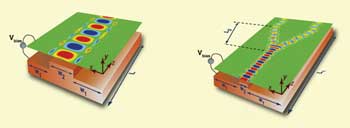Compiled by Photonics Spectra staff
One-atom-thick metamaterials that can now be made by controlling the conductivity
of sheets of graphene could have wide applications in imaging, signal processing
and telecommunications.
The study of metamaterials is based on the idea that devices can
be designed so that their overall wave qualities rely not only on their material
but also on the size, shape and pattern of irregularities – known as “inclusions,”
or “metamolecules” – embedded within host media. Two university
of Pennsylvania engineers said recently that by designing the properties of the
inclusions, along with their shapes and densities, they achieved something that
is not readily available in nature.
These unusual properties are generated from the manipulation of
electromagnetic or acoustic waves. In this case, electromagnetic waves from the
infrared spectrum were used. Changing the shape, speed and direction of these waves
is a subfield of metamaterials known as “transformation optics.”
The research, which appeared in the June 10 issue of Science (doi:
10.1126/science.1202691), shows how transformation optics might be achieved using
graphene – a lattice of carbon measuring a single atom thick.
By applying direct voltage to a sheet of graphene via a ground
plate running parallel to it, scientists changed the conductivity of graphene to
electromagnetic waves. Varying the voltage or the distance between the ground plate
and the graphene alters the conductivity.

A graphene waveguide and splitter. Courtesy of the University of Pennsylvania.
In this marriage between graphene and metamaterials, the different
regions of conductivity on the effectively two-dimensional, one-atom-thick sheet
function as the physical inclusions do in three-dimensional versions. With a computer
model, the scientists demonstrated a sheet of graphene having two different areas
of conductivity – one that can support a wave and one that cannot. The boundary
between the two areas acts as a wall that can reflect a guided electromagnetic wave
on the graphene much as one would in a 3-D space.
Another example of the material’s potential involves three
regions: one that can support a wave surrounded by two that cannot. This produces
a “waveguide” that functions as a one-atom-thick fiber optic cable.
A third example builds on this waveguide principle, adding another nonsupporting
region to split the waveguide into two.
The engineers tamed the wave to make it move and bend according
to their preference. This could allow for applications such as lensing and “flatland”
Fourier transforms, a fundamental aspect of signal processing that is found in nearly
every piece of technology with audio or visual components.